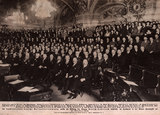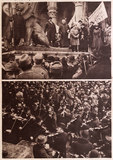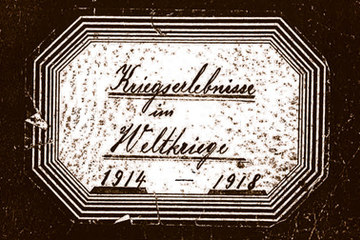-
Story The End of the War
The disintegration of the Habsburg Monarchy – Part II: The situation in Vienna and Budapest
-

The Provisional National Assembly of German Austria on 21 October 1918 in the Lower Austrian Landhaus in Vienna, photo from Das Interessante Blatt, issue of 31 October 1918
Copyright: ÖNB/ANNO
Partner: Austrian National Library -

The proclamation of the Republic of Hungary in front of the Budapest Parliament building. Newspaper photo from Wiener Bilder, issue of 5 December 1918
Copyright: ÖNB/ANNO
Partner: Austrian National Library
Once the other nationalities had confirmed their decision to leave the Dual Monarchy by proclaiming their independence, the two ‘peoples of state’ – the German Austrians and the Magyars – sought to prepare the ground for their respective futures.
On 21 October 1918 the German-speaking members of the Reichsrat held a constituent assembly at the Provincial Government of Lower Austria in Vienna, thus following the call for the formation of national committees issued by Emperor Karl in his manifesto ‘To My faithful Austrian peoples’.
The deputies present at the assembly represented the German-speaking constituencies of the Alpine and Danube lands and the Bohemian lands and had received their mandates at the last Reichsrat election in 1911. Because of the suspension of the Reichsrat from 1914 to 1917 there had been no further elections and the Emperor had extended the period of legislature until the end of 1918. The composition of the National Committee thus reflected the pre-war political situation, with the majority being conservatives from the liberal German nationalists or the Christian Socials. Although the Social Democrats were in a minority, the traditional elites’ loss of authority was so great that they were soon to gain the upper hand.
On 30 October 1918 this ‘Provisional National Assembly’ proceeded to found the state of ‘Deutschösterreich’ or ‘German-Austria’. The choice of the name was not so much an expression of German nationalist orientation as a reflection of how the actual state of affairs was seen at the time: the new state was to consist of the German-speaking areas of the Austrian half of the old Monarchy, that is to say, of the areas officially known as ‘Austria’ since 1917. German-Austria was more or less a virtual state without fixed borders, created in accordance with purely national-ethnic criteria in line with the maxim of the self-determination of the peoples.
Two options were developed for the future of German-Austria. One possibility was to join up with the successor states of the Habsburg lands to form a Danube federation on a democratic basis. If this turned out not to be possible for lack of interest on the part of the new states of Central Europe, the only other viable option was thought to be union with Germany. It was not originally intended that German-Austria should become a fully independent state, as finally turned out to be the most realistic option.
An ‘Executive Committee’, later called the ‘State Council’, was formed under the chairmanship of Karl Renner, who was entrusted with directing the business of government. The State Council operated in close cooperation with the ‘liquidation government’ under Heinrich Lammasch that had been convened on 27 October by Emperor Karl with the specific task of coordinating the dissolution of the Monarchy. On 11 November Karl’s ‘relinquishment of participation in the administration of the State’ drew a final line under the long history of Habsburg rule. The Republic was finally proclaimed on 12 November 1918 in Vienna.
In the Hungarian half of the Monarchy, on 24 October the Budapest government responded to the disintegration of the Austrian half by revoking the Compromise and reduced the link with Austria to the fact of personal union under a common monarch.
On 28 October a National Council was formed in Hungary under the chairmanship of Count Michael Károlyi with the goals of a swift peace, secession from the Habsburg Monarchy, the introduction of universal suffrage, and a programme of land reform. That there would be conflicts was inevitable because while the National Council demanded that Hungary should retain its historical borders, the non-Magyars such as the Slovaks, southern Slavs, and Rumanians had already declared the independence of their areas where they lived. The days of the coup saw acts of violence and rioting, in the course of which the former prime minister and ‘strong man of Hungary’ Count Tisza was shot on 31 October. The Republic of Hungary was proclaimed on 16 November, three days after Karl had been pressured into making a declaration of relinquishment as King of Hungary.
Translation: Peter John Nicholson
Bihl, Wolfdieter: Der Erste Weltkrieg 1914–1918. Chronik – Daten – Fakten, Wien/Köln/Weimar 2010
Hanisch, Ernst: Der lange Schatten des Staates. Österreichische Gesellschaftsgeschichte im 20. Jahrhundert [Österreichische Geschichte 1890–1990, hrsg. von Herwig Wolfram], Wien 2005
Hoensch, Jörg K.: Geschichte Ungarns 1867–1983, Stuttgart 1984
Rauchensteiner, Manfried: Der Erste Weltkrieg und das Ende der Habsburgermonarchie 1914–1918, Wien u. a. 2013
-
Chapters
- The course of the war 1917–1918: Face-to-face with imminent downfall
- The situation in the hinterland
- Apathy and resistance – The mood of the people
- The Sixtus Affair: A major diplomatic débacle
- A programme for world peace – President Wilson’s Fourteen Points
- ‘To My faithful Austrian peoples’ – Emperor Karl’s manifesto
- The collapse
- The disintegration of the Habsburg Monarchy – Part I: On the road to self-determination
- The disintegration of the Habsburg Monarchy – Part II: The situation in Vienna and Budapest
- The last days of the Monarchy








